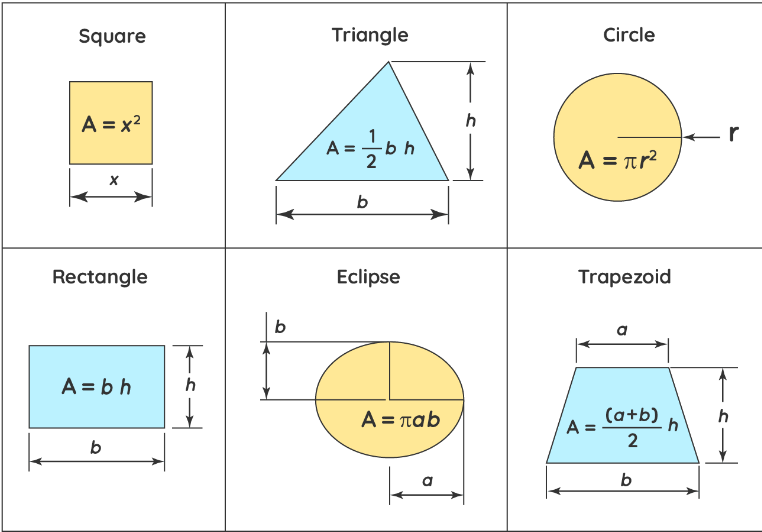The area is the space or region enclosed by a closed geometric figure in the 2-D plane. It's also a quantity that describes the plane extension of a two-dimensional figure, shape, or planar lamina. The space encompassed by various geometric forms is calculated using the area formulae. The formulas for geometric areas apply to normal geometric figures with defined dimensions.
What is Area?
Area refers to the measurement of the surface enclosed within the boundaries of a geometric shape. It is quantified in square units, which represent the total space covered by the shape on a two-dimensional plane. The concept of area is fundamental in geometry and is essential for a variety of applications, from determining the size of a room to calculating land coverage. Different geometric shapes have specific formulas to calculate their area, such as length times width for rectangles or π times the radius squared for circles. Understanding the area helps in real-world scenarios such as architecture, land planning, and even art.

What Are Area Formulas?
Various Areas The area of various geometric forms is calculated using formulas. The square, rectangle, circle, triangle, trapezoid, and ellipse are some of the most important geometric figures.
1. Area Formula For Triangle
Finding half of the product of the base and height of a triangle can be used to calculate its area. The formula for calculating the area of a triangle is as follows:
Area of a Triangle = 1/2 × Base × Height
2. Area Formula For Square
The area of a square is obtained by calculating the square of each side's length. The formula for calculating the area of a square is as follows:
Area of Square = Side × Side = Side2
3. Area Formula For Circle
Finding the product of pi and the square of the radius yields the area of the circle. The formula for calculating the area of a circle is as follows:
Area of a Circle = πr2
4. Area Formula For Rectangle
A rectangle's area is calculated by multiplying its length and width together. The formula for calculating the area of a rectangle is as follows:
Area of Rectangle = Length × Breadth
5. Area Formula For Parallelogram
The area of a parallelogram can be computed by multiplying the parallelogram's base and height. The formula for calculating the area of a parallelogram is as follows:
Area of a Parallelogram = Base × Height
6. Area Formula For a Rhombus
Finding half of the product of the diagonal lengths of a rhombus can be used to calculate its area. The formula for calculating the area of a quadrilateral is as follows:
Area of a Rhombus = 1/2 × product of diagonals
7. Area Formula For a Trapezoid
A trapezoid's area is half of the sum of its parallel sides and height. The formula for calculating the area of a trapezoid is as follows:
Area of a Trapezoid = 1/2 × Sum of Parallel Sides (a + b) × Height(h)
8. Area Formula For Ellipse
The product of pi with a major and minor axis equals the area of an ellipse. The formula for ellipse area is as follows:
Area of Ellipse = π × Major axis(a) × Minor Axis(b)
Solved Examples Using Geometric Area Formula
Q1. Find the area of a rectangle with a length of 8 cm and a width of 5 cm.
Solution: Using the formula:
Area = 8cm × 5cm = 40cm^2
So, the area of the rectangle is 40 cm
Q2. Find the area of a triangle with a base of 10 cm and a height of 6 cm.
Solution: Using the formula:
1/2 × 10cm × 6cm = 30cm^2
So, the area of the triangle is 30 cm^2
Q3. Find the area of a circle with a radius of 4 cm.
Area=π×(4cm)^2 ≈ 3.14 × 16cm^2;≈ 50.24cm^2
Q4. Find the area of a rhombus with diagonals of 7 cm and 5 cm.
Using this formula: 1/2 × D1 * D2
1/2 × 7cm × 5cm = 1/2 * 35 cm^2 = 17.5 cm^2